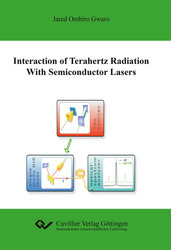| Fachbereiche | |
|---|---|
| Buchreihen (96) |
1378
|
| Nachhaltigkeit |
3
|
| Gesundheitswesen |
1
|
| Geisteswissenschaften |
2364
|
| Naturwissenschaften |
5406
|
| Ingenieurwissenschaften |
1792
|
| Allgemeine Ingenieurwissenschaften | 292 |
| Maschinenbau und Verfahrenstechnik | 862 |
| Elektrotechnik | 686 |
| Bergbau- und Hüttenwesen | 30 |
| Architektur und Bauwesen | 75 |
| Allgemein |
98
|
|
Leitlinien Unfallchirurgie
5. Auflage bestellen |
|
Erweiterte Suche
Interaction of Terahertz Radiation with Semiconductor Lasers
Jared Ombiro Gwaro (Autor)Vorschau
Inhaltsverzeichnis, PDF (26 KB)
Leseprobe, PDF (440 KB)
Terahertz (THz) technology bears great potential in spectroscopy, imaging, material science, security screening and high-speed wireless communication. However, the generation of intensive, directional THz radiation has been difficult and the THz frequency range has long been considered the last final frontier of the electromagnetic spectrum. Recent advancement in optoelectronic terahertz generation techniques and high power electronic sources has helped to bridge the THz gap and has opened up a wealth of new applications for THz technology. However, there is still a major technical limitation in developing THz systems for mass markets, mainly due to the cost of THz hardware components including sources and detectors.
In this regard, we investigated the use of semiconductor diode lasers as THz detectors as well as excitation sources for photomixers for THz generation. For THz detection, we investigated the interaction of semiconductor lasers with THz radiation. Intense THz radiation from different sources and at various frequencies was injected into the laser diode. The laser diode was operated in Littman configuration to ensure clean single mode operation in the near infrared. The charge carrier system in the semiconductor was expected to interact with the injected THz radiation and introduce nonlinear frequency mixing. This nonlinear mixing was to induce sidebands in the near infrared optical spectra and was to be analyzed with an optical spectrum analyzer. This may lead to the demonstration of a simple, cost effective and compact room temperature THz spectrometer since the distance between the emission line and the sidebands equals the incident THz frequency. Unfortunatly, due to unprecedented challenges the interaction of THz radiation with diode laser experiment was not successful.
Another approach was to demonstrate a compact and cost effective THz source based on monolithic distributed Bragg reflector diode laser emitting two frequencies simulteneously. We successfully demonstrated 300 GHz continuous wave THz radiation, with fiber coupled ion implanted photoconductive antennas used as photomixing devices. The generated THz radiation was tunable via temperature adjustments and current injection. This approach provided a coarse tuning in the range of 286 GHz to 320 GHz. We successfully demonstrated its potential use in non-destructive plant moisture measurements of a leaf induced to drought stresses and for moisture monitoring in drying process of pieces of paper.
Due to the fact that the tuning of the developed THz source was coarse, we proposed the use of a new diode which was electrically tunable for fine tuning of the generated THz frequency. The new diode offers optical beat signal adjustments via carrier injection to the DBR section using micro resistor heater integrated on top of the DBR segment. The optical beat tuning via carrier injection was fast and offers tuning which should be free from mode hopping. The injection current to the resistor heater can be adjusted between 0 to 350 mA, an optical beat adjustment of between 100 GHz-300 GHz was realized. This bandwidth was only limited with the overlap of the two modes at higher heater currents of 250 mA to 350 mA. THz radiation emission via photomixing in the range 100 GHz-300 GHz was successfully demonstrated, these results were in good agreement with the optical beat signal measurements. Finally, a simple spectrometer suitable for THz metrology measurements such as thickness determination of Polyethylene sample (PE) was realized and also its application in THz spectroscopy was demonstrated by the determination of the spectroscopic transmission characteristics of a THz filter.
In summary, two compact THz sources emitting at 300 GHz were successfully demonstrated and this was a major milestone towards development of compact and cost effective THz system for mass market application.
| ISBN-13 (Printausgabe) | 9783736970373 |
| ISBN-13 (E-Book) | 9783736960374 |
| Buchendformat | A5 |
| Sprache | Englisch |
| Seitenanzahl | 126 |
| Umschlagkaschierung | glänzend |
| Auflage | 1. |
| Erscheinungsort | Göttingen |
| Promotionsort | Bochum |
| Erscheinungsdatum | 18.06.2019 |
| Allgemeine Einordnung | Dissertation |
| Fachbereiche |
Elektrotechnik
|
| Schlagwörter | Terahertz radiation, semiconductor diode lasers, photoconductive antenna and continuous wave |








